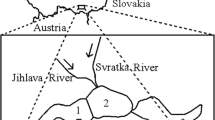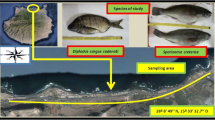Abstract
Submarine canyons are regarded as a sink for pollutants. In order to determine if this theory applied to deep-sea species from an important fishing ground (the Blanes submarine canyon) located in the NW Mediterranean, we sampled the commercial fish Phycis blennoides and Micromesistius poutassou and the crustacean Aristeus antennatus. Specimens were sampled inside and outside (in the open continental slope) the submarine canyon; both are regarded as potentially affected by exposure to different anthropogenic chemicals. Several pollution biomarkers in muscle (activity of cholinesterases) and liver/hepatopancreas (catalase, glutathione S-transferases, carboxylesterases, ethoxyresorufin O-deethylase in fish or mixed function oxygenase (MFO)-related reductases in crustacean, and lipid peroxidation levels) were measured. Chemical analysis of the persistent organic pollutants, namely polychlorinated biphenyls (PCBs), dichlorodiphenyltrichloroethanes (DDTs) and hexachlorocyclohexanes (HCHs) was also performed on the fish and crustacean muscle. Biomarker activities and levels were discussed in relation to pollutant exposure, habitat, and parameters including sex, size, and species. Biochemical responses and chemical analysis of PCBs evidenced interspecies differences as well as sex and size-related ones, mainly in A. antennatus. An indication of higher exposure to pollutants inside the canyon was observed, which was more clearly reflected in the fish than in the crustacean. However, further research is required to confirm this observation.


Similar content being viewed by others
References
Aebi H (1974) Catalase. In: Bergmayer HU (ed) Methods of enzymatic analysis. Academic, London, pp 671–684
Al-Ghais SM, Ahmad S, Ali B (2000) Differential inhibition of xenobiotic-metabolizing carboxylesterases by organotins in marine fish. Ecotox Environ Safe 46:258–264. doi:10.1006/eesa.2000.1928
Ballschmiter KH, Froescheis O, Jarman WM, Caillet G (1997) Contamination of the deep-sea. Mar Pollut Bull 34:288–289. doi:10.1016/S0025-326X(96)00090-2
Berdié L, Grimalt JO (1998) Assessment of the sample handling procedures in a labor-saving method for the analysis of organochlorine compounds in a large number of fish samples. J Chromatogr A 823:373–380. doi:10.1016/S0021-9673(98)00517-2
Bocio A, Domingo JL, Falcó G, Llobet JM (2007) Concentration of PCDD/PCDFs and PCBs in fish and seafood from the Catalan (Spain) market. Environ Int 33:170–175. doi:10.1016/j.envint.2006.09.005
Bonacci S, Iacocca A, Fossi S, Lancina L, Caruso T, Corsi I, Focardi S (2007) Biomonitoring aquatic environmental quality in a marine protected area: a biomarker approach. Ambio 36:308–315. doi:10.1579/0044-7447(2007)36[308:BAEQIA]2.0.CO;2
Borghi V, Porte C (2002) Organotin pollution in deep-sea fish from the Northwestern Mediterranean. Environ Sci Technol 36:4224–4228. doi:10.1021/es025725c
Bouloubassi I, Mejanelle L, Pete R, Fillaux J, Lorre A, Point V (2006) PAH transport by sinking particles in the open Mediterranean Sea: A 1 year sediment trap study. Mar Pollut Bull 52:560–571. doi:10.1016/j.marpolbul.2005.10.003
Bradford M (1976) A rapid and sensitive method for the quantification of microgram quantities of protein utilizing the principle of protein dye binding. Anal Biochem 72:248–254. doi:10.1016/0003-2697(76)90527-3
Burke MD, Mayer RT (1974) Ethoxyresorufin: Direct fluorimetric assay of a microsomal O-dealkylation which is preferentially inducible by 3-methylcholanthrene. Drug Met Dispos 2:583–588
Cajaraville MP, Bebianno MJ, Blasco J, Porte C, Sarasquete C, Viarengo A (2000) The use of biomarkers to assess the impact of pollution in coastal environments of the Iberian Peninsula: a practical approach. Sci Total Environ 247:201–212. doi:10.1016/S0048-9697(99)00491-X
Canals M, Puig P, Durrieu de Madron X, Heussner S, Palanques A, Fabrés J (2006) Flushing submarine canyons. Nature 444:354–357. doi:10.1038/nature05271
Company JB, Puig P, Sardà F, Palanques A, Latasa M, Scharek R (2008) Climate Influence on Deep Sea Populations. PLoS ONE 1:e1431. doi:10.1371/journal.pone.0001431
Drava G, Capelli R, Minganti V, De Pellegrini R, Relini LD, Ivaldi M (2004) Trace elements in the muscle of red shrimp Aristeus antennatus (Risso, 1816) (Crustacea, Decapoda) from Ligurian Sea (NW Mediterranean): variations related to the reproductive cycle. Sci Total Environ 321:87–92. doi:10.1016/j.scitotenv.2003.09.005
Ellman GL, Courtney KD, Andres VJ, Featherstone RM (1961) A new and rapid colorimetric determination of acetylcholinesterase activity. Biochem Pharmacol 7:88–95. doi:10.1016/0006-2952(61)90145-9
Escartín E, Porte C (1996) Acetylcholinesterase inhibition in the crayfish Procambarus clarkii exposed to fenitrothion. Ecotox Environ Safe 34:160–164. doi:10.1006/eesa.1996.0058
Fossi MC, Savelli C, Casini S (1998) Mixed function oxidase induction in Carcinus aestuarii. Field and experimental studies for the evaluation of toxicological risk due to Mediterranean contaminants. Comp Biochem Physiol 121C:321–331
Galloway TS, Brown RJ, Browne MA, Dissanayake A, Lowe D, Jones MB, Depledge MH (2006) A multibiomarker approach to environmental assessment. Environ Sci Technol 38:1723–1731. doi:10.1021/es030570+
García de la Parra LM, Porte C, Albaigés J (2000) Organochlorinated pollutants and xenobiotic metabolizing enzymes in W. Mediterranean mesopelagic fish. Mar Pollut Bull 40:764–768. doi:10.1016/S0025-326X(00)00023-0
Gili JM, Pagès F, Bouillon J, Palanques A, Puig P, Heussner S, Calafat A, Canals M, Monaco A (2000) A multidisciplinary approach to the knowledge of hydromedusan populations inhabiting Mediterranean submarine canyons. Deep Sea ResI 47:1513–1533. doi:10.1016/S0967-0637(99)00119-3
Habig WH, Pabst MJ, Jakoby WB (1974) Glutathione S-transferases. The first enzymatic step in mercapturic acid formation. J Biol Chem 249:7130–7139
Homola E, Chang ES (1997) Distribution and regulation of esterases that hydrolise methyl farnesoate in Homarus americanus and other crustaceans. Gen Comp Endocrinol 106:62–72. doi:10.1006/gcen.1996.6850
James MO, Boyle SM (1998) Cytochrome P450 in Crustacea. Comp Biochem Physiol 121C:157–172
Jewell CSE, Winston GW (1989) Characterization of the microsomal mixed-function oxygenase system of the hepatopancreas and green gland of the red swamp crayfish, Procambarus clarkii. Comp Biochem Physiol 92B:329–339
Monaco A, Biscaye P, Soyer J, Pocklington R, Heussner S (1990) Particle fluyes and ecosystem response on a continental margin: the 1985–1988 Mediterranean ECOMARGE experiment. Cont Shelf Res 10:809–839. doi:10.1016/0278-4343(90)90061-P
Mourente G, Díaz-Salvago E (1999) Characterization of antioxidant systems, oxidation status and lipids in brain of wild-caught size-class distributed Aristeus antennatus (Risso, 1816) Crustacea, Decapoda. Comp Biochem Physiol 124B:405–416
Palanques A, Durrieu de Madron X, Puig P, Fabres J, Guillén J, Calafat A, Canals M, Heussner S, Bonnin J (2006a) Suspended sediment fluxes and transport processes in the Gulf of Lions submarine canyons. The role of storms and dense water cascading. Mar Geol 234:43–61. doi:10.1016/j.margeo.2006.09.002
Palanques A, Martín J, Puig P, Guillen J, Company JB, Sardà F (2006b) Effects of sediment gravity flows induced by trawling in the Palamos (Fonera) submarine canyon. Deep-Sea Res I 53:201–214. doi:10.1016/j.dsr.2005.10.003
Pastor D, Boix J, Fernández V, Albaigés J (1996) Bioaccumulation of organochlorinated contaminants in three estuarine fish species (Mullus barbatus, Mugil cephalus and Dicentrarcus labrax). Mar Pollut Bull 32:257–262. doi:10.1016/0025-326X(95)00166-K
Porte C, Albaigés J (1993) Bioaccumulation patterns of hydrocarbons and polychlorinated biphenyls in bivalves, crustaceans, and fishes. Arch Environ Contam Toxicol 26:273–281
Porter NA, Caldwell SE, Mills KA (1995) Mechanisms of free radical oxidation of unsaturated lipids. Lipids 30:277–290. doi:10.1007/BF02536034
Rotllant G, Abad E, Sardà F, Abalos M, Company JB, Rivera J (2006) Dioxin compounds in the deep-sea rose shrimp Aristeus antennatus (Risso, 1816) throughout the Mediterranean Sea. Deep-Sea Res I 53:1895–1906. doi:10.1016/j.dsr.2006.09.004
Shaw J, Large AT, Donkin P, Evans SV, Staff FJ, Livingstone DR, Chipman JK, Peters LD (2004) Seasonal variation in cytochrome P450 immunopositive protein levels, lipid peroxidation and genetic toxicity in digestive gland of the mussel Mytilus edulis. Aquat Toxicol 67:325–336. doi:10.1016/j.aquatox.2004.01.013
Snyder MJ (2000) Cytochrome P450 enzymes in aquatic invertebrate: recent advances and future directions. Aquat Toxicol 48:529–547. doi:10.1016/S0166-445X(00)00085-0
Solé M, Livingstone DR (2005) Components of the cytochrome P450-dependent monooxygenase system and ‘NADPH-independent benzo[a]pyrene hydroxylase’ activity in a wide range of marine invertebrate species. Comp Biochem Physiol 141C:20–31
Solé M, Porte C, Albaigés J (2001) Hydrocarbons, PCBs and DDT in the NW Mediterranean deep-sea fish Mora moro. Deep-Sea Res I 48:495–513. doi:10.1016/S0967-0637(00)00056-X
Solé M, García de la Parra LM, Alejandre-Grimaldo S, Sardá F (2006) Esterase activities and lipid peroxidation levels in offshore commercial species of the NW Mediterranean Sea. Mar Pollut Bull 52:1708–1716. doi:10.1016/j.marpolbul.2006.07.015
Solé M, Lobera G, Aljinovic B, Ríos J, García de la Parra LM, Maynou F, Cartes JE (2008) Cholinesterases activities and lipid peroxidation levels in muscle from shelf and slope dwelling fish from the NW Mediterranean: its potential use in pollution monitoring. Sci Total Environ 402:306–317. doi:10.1016/j.scitotenv.2008.04.041
Stergiou KI, Karpouzi VS (2002) Feeding habits and trophic levels of Mediterranean fish. Rev Fish Biol 11:217–254. doi:10.1023/A:1020556722822
Van der Oost R, Beyer J, Vermeulen NPE (2003) Fish bioaccumulation and biomarkers in environmental risk assessment: a review. Environ Toxicol Pharmacol 13:57–149. doi:10.1016/S1382-6689(02)00126-6
Varó I, Navarro JC, Amat F, Guilhermino L (2003) Effect of dichlorvos on cholinesterase activity of the European sea bass (Dicentrarchus labrax). Pestic Biochem Physl 75:61–72. doi:10.1016/S0048-3575(03)00019-1
Wheelock CE, Eder KJ, Werner I, Huang H, Jones PD, Brammell BF, Elskus AA, Hammock BD (2005) Individual variability in esterase activity and CYP1A levels in Chinook salmon (Oncorhynchus tshawytscha) exposed to esfenvalerate and chlorpyrifos. Aquat Toxicol 74:172–192. doi:10.1016/j.aquatox.2005.05.009
Whyte JJ, Jung RE, Schmitt CJ, Tilltitt DE (2000) Ethoxyresorufin O-deethylase (EROD) activity in fish as a biomarker of chemical exposure. Crit Re Toxicol 30:347–570. doi:10.1080/10408440091159239
Acknowledgements
This work was financed by the Spanish Science and Technology Ministry through the project RECS (REN2002-04556-CO2-01/MAR). Bastian Hambach acknowledges a grant from the Agency for Management of University and Research Grants in Catalonia (AGAUR). Jorge D. Sanchez and Cristina de Castro are acknowledged for field sampling support as well as the skipper and crew of the Montse II fishing boat.
Author information
Authors and Affiliations
Corresponding author
Rights and permissions
About this article
Cite this article
Solé, M., Hambach, B., Cortijo, V. et al. Muscular and Hepatic Pollution Biomarkers in the Fishes Phycis blennoides and Micromesistius poutassou and the Crustacean Aristeus antennatus in the Blanes Submarine Canyon (NW Mediterranean). Arch Environ Contam Toxicol 57, 123–132 (2009). https://doi.org/10.1007/s00244-008-9250-2
Received:
Accepted:
Published:
Issue Date:
DOI: https://doi.org/10.1007/s00244-008-9250-2




